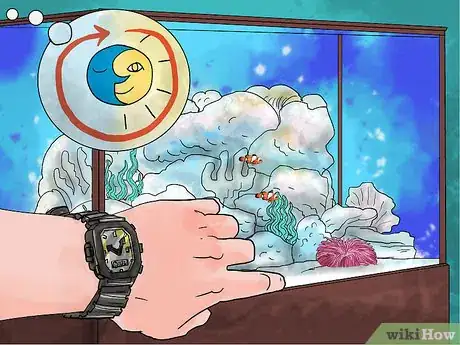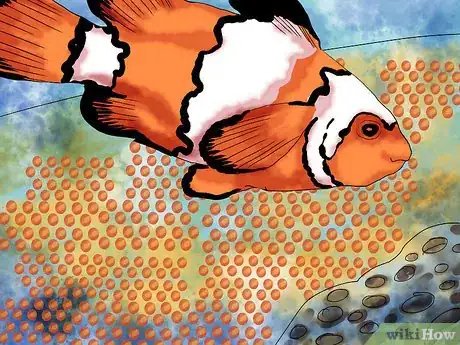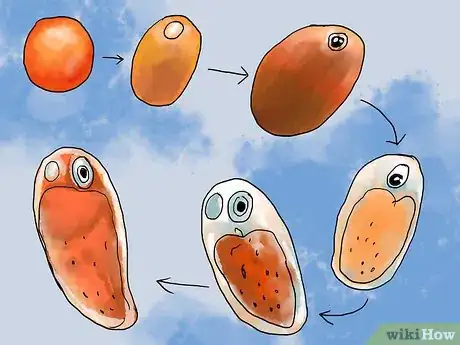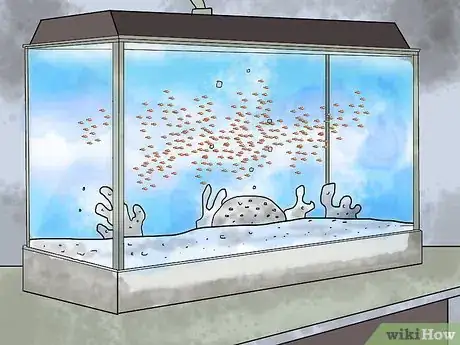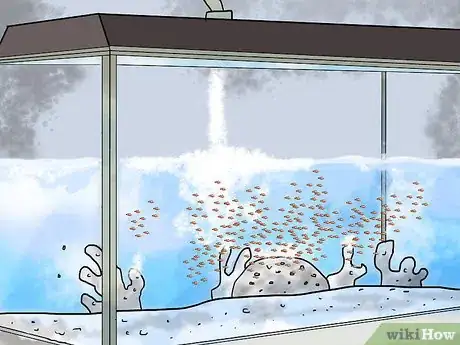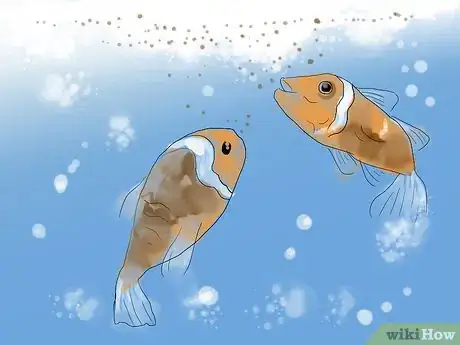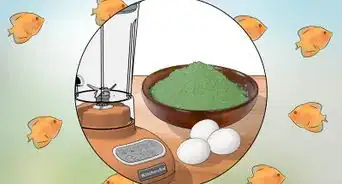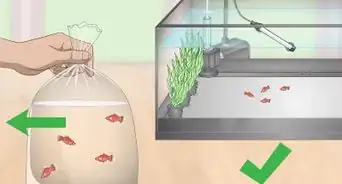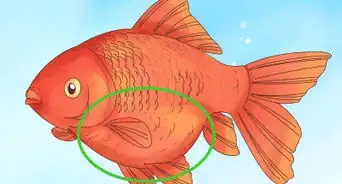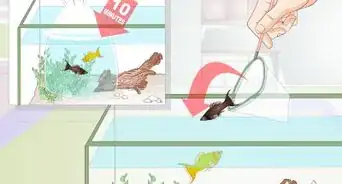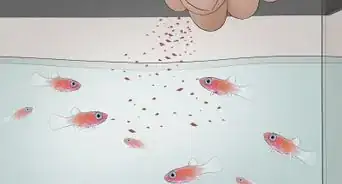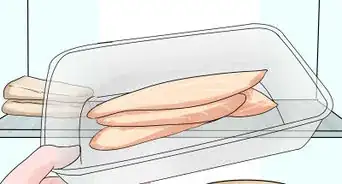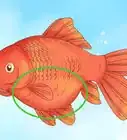This article was co-authored by Marshall Stephens. Marshall Stephens is an Aquarium Expert at Private Oceans Aquariums in West Palm Beach, Florida. Marshall has over 20 years of experience in the aquarium industry and focuses on captive-bred animals. They specialize in tropical and marine aquariums and are a contributor to the Loggerhead Marine life center in Jupiter Florida.
There are 7 references cited in this article, which can be found at the bottom of the page.
wikiHow marks an article as reader-approved once it receives enough positive feedback. In this case, several readers have written to tell us that this article was helpful to them, earning it our reader-approved status.
This article has been viewed 284,322 times.
Clownfish are small, brightly colored fish that make a delightful addition to any home saltwater aquarium. They can be fun to raise and can be easily bred at home with some care, attention, and know-how. Here are some basic steps that will help you successfully breed clownfish in your own aquarium.
Steps
Preparing to Breed a Clownfish Pair
-
1Make sure you are very familiar with the basics of keeping a saltwater aquarium. Breeding fish is a project that should be taken on by people who are experienced with saltwater aquarium set up and maintenance. While breeding these fish is not difficult, it does require a bit of knowledge about fish feeding and life cycles, not to mention having the right supplies to assure proper tank filtration and ecosystem development.
- If you want to begin setting up your own aquarium, you may want to consult How to Start a Saltwater Aquarium or How to Set up a Marine Reef Aquarium before diving into breeding fish.
- Specialists usually don't recommend breeding clownfish unless you want to start an aquaculture business. It's important to think long term and not only on the cuteness of baby clownfish.
-
2Get a mated pair from an aquarium store. Clownfish are external breeders, meaning that the female fish lays eggs and then the male fish fertilizes them after they have been laid. To make this happen you will need to get a pair of clownfish that are already bonded, in other words mated to each other.
- Many aquarium stores will sell mated pairs specifically for clownfish breeding. If your store does not have any in stock, they can probably special order a pair just for you. Don't be afraid to ask!
Advertisement -
3Develop a mated pair. The other way you can get a mated pair is to develop two young clownfish into a bonded pair yourself. Begin by buying two clownfish when they are still young. One of the amazing things about clownfish is that they are all born neither male or female, so you don't have to worry about getting one male and one female.[1] Any pair will do.
- Developing into a male or female fish only occurs as the fish get older. The sex of your fish will actually be determined by the dominance of the fish when fighting each other. The dominant fish will change sex into a female and the less dominant will become male.
- If you are keeping a lot of clownfish in the same tank, only one bonded pair will develop. The most dominant of all will become female and the second most dominant will become male. The rest will remain sexless.[2]
- If you want to keep the fighting to a minimum and make the fish change sex as quickly as possible, it is a good idea to get one clownfish that is larger than the other, that way it is clear from the get go which one is dominant.
-
4Keep the water in your tank clean. Clownfish are not as sensitive to water conditions as other fish can be, but keeping the water clean can make them more likely to breed.
-
5Place plants and rocks in your aquarium. Placing anemone in the tank to make the clownfish feel more comfortable. Although this is not totally necessary, it will increase the likelihood that your pair will breed. You should also have live rock in your tank. Live rock is rock that is from the ocean and is the foundation of the development of coral reefs. The live rock will provide the fish have hiding places and will give a surface on which the clownfish can lay and care for their eggs.
-
6Keep your aquarium lighting on a timer. Keep it light during the day and dark at night on a regular schedule. This regularity will keep your clownfish more relaxed, and thus more likely to spawn.
-
7Recognize the changes in clownfish behavior that signal spawning. The female, the bigger of your two fish, will get thicker around her middle, indicating she is getting ready to release eggs. Both fish may also start to clean the rocks with their mouth and fins to get it ready for the eggs.
-
8Keep a look out for the clownfish eggs. Once the eggs are laid they will be orange in color and attached to the rocks. The male clownfish will care for them, swimming around them and waving his fins on them to aerate them. He may also pick off the ones that have died.
-
9Track changes in the clownfish eggs. Clownfish eggs go through multiple stages of development. As stated before, they begin as an orange color but shift
- The eggs should hatch in about 7 to 10 days. You will need to feed the fry live rotifers for the first week. Rotifers are plankton that many species feed on. After that, you can start to introduce live brine shrimp. Clownfish babies will only eat live food.
-
10Set up a separate hatchling tank once the eggs are laid. It does not need to be very big, a 10 gallon (37.8 l) tank will do fine for the hatchlings. Make sure the tank does not have a large filtration system but instead has an air stone that lets off little bubbles or some other more gentle means of oxygenation.[3] Too much filtration could easily kill all your tiny fry.
- You must also provide proper lighting for the fry since they will be searching for food but their vision is not the greatest. The light shouldn't be too bright, one light bulb is sufficient, and should be as diffused as possible.
Raising Clownfish Fry
-
1Move the hatchlings to a separate tank. Some breeders move the eggs before they hatch but most wait until the hatchlings come out of their eggs, as moving the hatchlings is easier.[4] Either way, you will need to raise the fry in a separate aquarium as clownfish are known to eat their own eggs and hatchlings. Be sure to get the extra tank ready ahead of time.
-
2Feed your clownfish hatchlings. While in the egg sack, the embryos use energy from the yoke to survive, but once they emerge, the hatchlings will need food fast!
- Clownfish hatchlings should be fed live rotifers, which are microscopic aquatic animals.[5] These can sometimes be found at an aquarium store but you should check with yours to make sure.
- Many clownfish breeders find it easier to breed rotifers for their hatchlings to eat, than it is to find them at an aquarium store. Make sure you have a steady supply of them before beginning the breeding process, otherwise your hatchlings will die at this stage.
-
3Change 20-50% of the water in their tank daily.[6] This is important in order to keep the water clean but it also assures that the water is clear enough for the hatchlings to see the rotifers they need to eat.
-
4Expect some of your fry to not make it through the transition from a fry to a fish.[7] One of the hardest transitions in the life of a clownfish is when they move from their larval stage to being a juvenile clownfish.
- To give them a good shot at developing, transition their food from rotifers to live brine shrimp so that they can get enough energy to grow rapidly. You can also add nutrients to the water, such as those sold for keep saltwater reef tanks healthy.
-
5Watch as your fry turn into juvenile fish. If the fish make it through the transition, you should start seeing the distinctive color of the clownfish develop on your fish. They should continue to grow rapidly, so make sure you continue to give them enough food and to keep their water clear and clean.
Community Q&A
-
QuestionMy clownfish won't stop laying eggs. What should I do?
 Dan PeckfordCommunity AnswerNothing! You are lucky enough to witness one of nature's miracles. Clownfish can lay up to 1000 eggs at once! If you do not wish to raise them all, I suggest you get in touch with a breeder of clownfish or a local aquarium store and ask about re-homing all those little guys.
Dan PeckfordCommunity AnswerNothing! You are lucky enough to witness one of nature's miracles. Clownfish can lay up to 1000 eggs at once! If you do not wish to raise them all, I suggest you get in touch with a breeder of clownfish or a local aquarium store and ask about re-homing all those little guys. -
QuestionDo I have to get a live rock or can I use sand?
 Community AnswerLive rocks are the best, no matter what type of fish you are breeding.
Community AnswerLive rocks are the best, no matter what type of fish you are breeding. -
QuestionWhere do Clownfish produce their eggs?
 Community AnswerIn different hiding spots that they find on live rock. The live rock will provide the fish with hiding places and will give a surface on which the clownfish can lay and care for their eggs.
Community AnswerIn different hiding spots that they find on live rock. The live rock will provide the fish with hiding places and will give a surface on which the clownfish can lay and care for their eggs.
Warnings
- Do not put different species of clownfish together. They will fight and cause each other stress, and they will not lay any eggs if that happens.⧼thumbs_response⧽
Expert Interview

Thanks for reading our article! If you'd like to learn more about taking care of a fish, check out our in-depth interview with Marshall Stephens.
References
- ↑ http://www.ocellarisclownfish.com/ocellaris-clownfish-male-female/
- ↑ http://www.fishchannel.com/saltwater-aquariums/species-info/clownfish/breeding-clownfish.aspx
- ↑ http://www.firsttankguide.net/airstones.php
- ↑ http://www.fishchannel.com/saltwater-aquariums/species-info/clownfish/breeding-clownfish.aspx
- ↑ http://www.ucmp.berkeley.edu/phyla/rotifera/rotifera.html
- ↑ http://fish.mongabay.com/breeding.htm
- ↑ https://www.youtube.com/watch?v=48Q-jVqDcDI
- http://www.aquaticcommunity.com/clownfish/breeding.php
About This Article
To breed clownfish, purchase a mated pair of fish, or 2 fish that are already bonded, from an aquarium store. Place plants, anemone, and rocks in the tank, and keep the water in the tank clean, which can help make the fish more likely to breed. Turn off the lights in the aquarium at night, which may also help the fish feel relaxed enough to breed. Once you see eggs in the tank, set up a separate hatchling tank with an air stone and a diffused light. You can either move the eggs or wait until the hatchlings come out of the eggs to move them to the new tank. For tips on caring for your hatchlings, read on!





